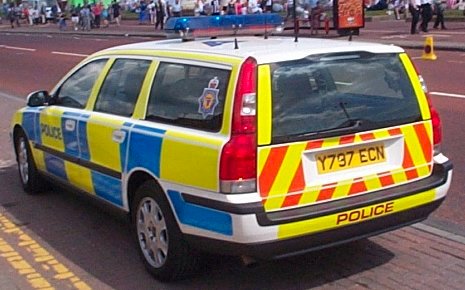Fundamentals
From country to country and sometimes, from county to county, there can be a big difference in the color scheme of police patrol cars. They are meant to be readily identifiable in all cases, but some police forces use remarkably bright coloration for conspicuity. This is intended not only to assist with officer safety at traffic stops and accident scenes but also to increase deterrence among drivers who might otherwise be breaking traffic laws if they failed to see a patrol vehicle.
In the UK, for example, where the rate of road crash fatalities is regularly the lowest (i.e., best) in the world [details here], virtually all patrol police cars are designed for maximum conspicuity and often park in very prominent locations, so that all drivers can see them.
It could be argued that speeding drivers slow down until they’ve passed the patrol car and then speed up again, but even one prominent patrol car every 20-30 miles tends to have people saying, “The police were out in strength today” (or blunter words to that effect!).
As in many other countries, UK forces often have the word ‘police’ printed backward across the hood/bonnet so that it may be easily read through a rearview mirror.

The move to maximize the conspicuity of patrol cars by British police forces has primarily occurred over the last 10-15 years. However, a typical color scheme before that is illustrated above right. In earlier years, the predominantly red or orange stripe along the side of the cars earned them the popular nickname of ‘jam sandwiches’ (though in American terminology, that should perhaps be ‘jelly sandwiches.’)

occupants when static. The widely-used 70-series T5 Volvo — both as the saloon/sedan S70 and the estate/wagon
V70 — has proved to be adequately fast (155mph), highly effective, and extremely popular with officers.
© Copyright photo courtesy of ‘UK Emergency Vehicles’ www.ukemergency.f9.co.uk/index.htm
In some countries, one finds some remarkably drab color schemes, which makes patrol vehicles much harder to see from a distance. This may be great for catching more speeders, but there are times when it significantly reduces safety for the officers concerned. It also reduces the deterrent effect that has been used with particular success by Australian police forces.
April 28, 2022
To improve highway safety, the Pennsylvania State Police is adding a strip of highly reflective yellow and black material to the rear of marked patrol vehicles, State Police Commissioner Jeffrey B. Miller announced today.
“The intent is to make our cars easier for motorists to see, particularly after dark,” Col. Miller said.
Col. Miller said the idea for increasing the reflective markings grew from a national study examining ways to reduce the number of rear-end collisions involving police cars struck by other vehicles.
Richard O. Binker, director of the State Police Transportation Division, said the Department tested with various types of reflective material and different color combinations.
“The decision to use yellow and black markings was made because of their visibility and recognition by the motoring public as a commonly used marking associated with barriers and other stationary objects,” Binker said. According to Binker, State Police has about 1,000 marked patrol vehicles.

The Use of Unmarked Police Cars
Many countries &/or states now use unmarked patrol cars, often to combat speeding. However, according to the American Automobile Association [AAA], Washington State Patrol has successfully used this method to fight aggressive drivers since 1998.
Even though the aggressive driving team members make up less than 2 percent of the troopers on the road, they account for 17 percent of the aggressive driver stops. For example, in the twelve months ending July 2022, the soldiers pulled over 37,120 drivers statewide and issued 46,170 citations [i.e., tickets] to those drivers.
Troopers assigned to this program look for motorists committing multiple violations, from speeding to HOV (“High-Occupancy Vehicle”) lane violations to weaving in and out of traffic. And the program had such a sound effect that twelve unmarked police cars were ordered for delivery before the end of 2003.
